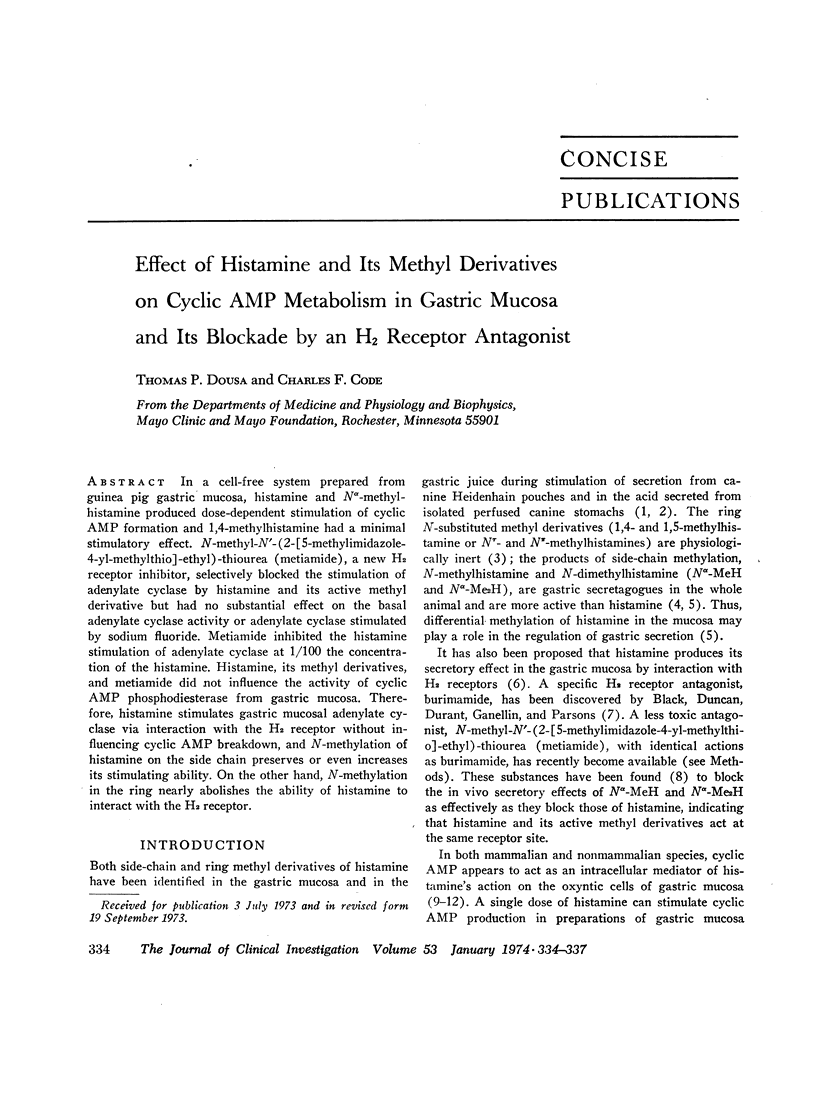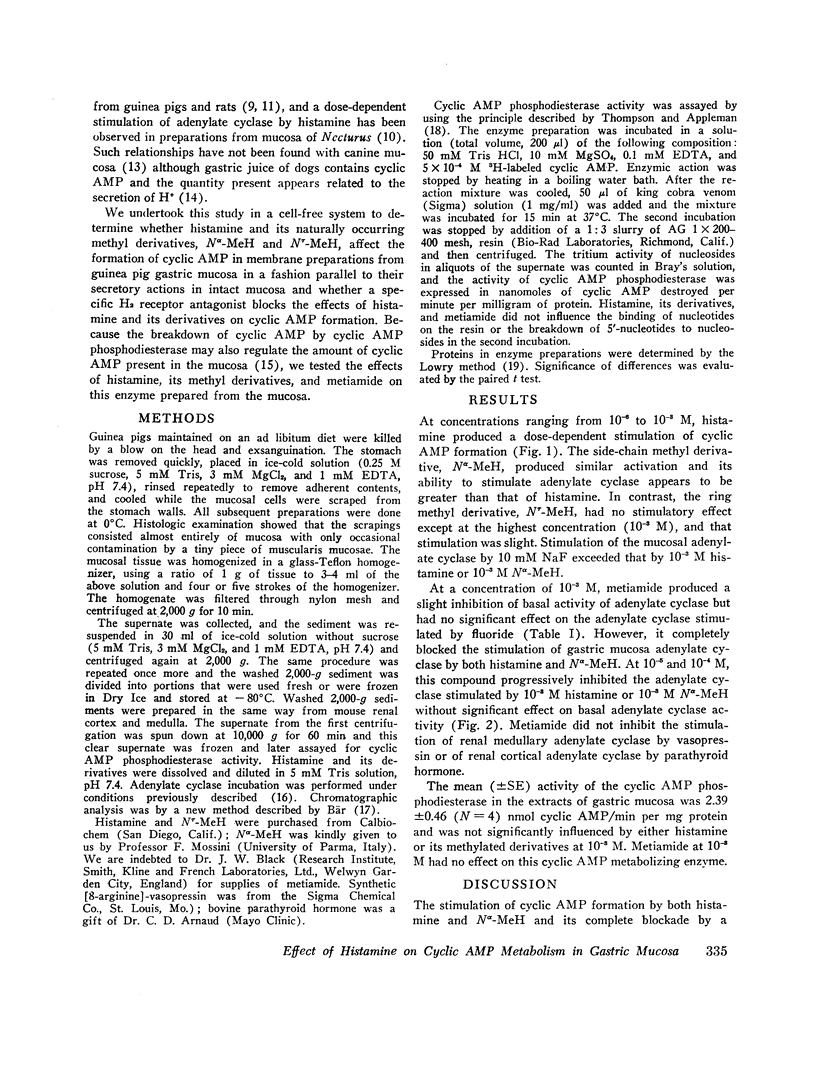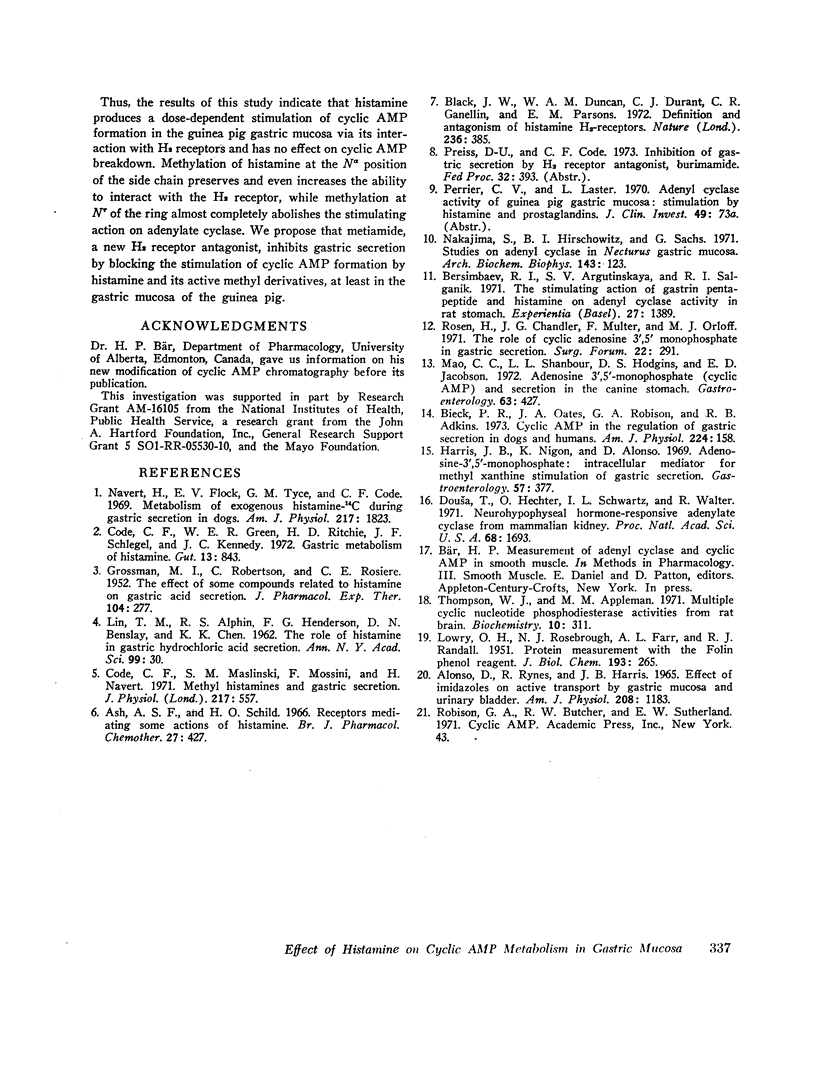Abstract
In a cell-free system prepared from guinea pig gastric mucosa, histamine and Nα-methyl-histamine produced dose-dependent stimulation of cyclic AMP formation and 1,4-methylhistamine had a minimal stimulatory effect. N-methyl-N′-(2-[5-methylimidazole-4-yl-methylthio]-ethyl) -thiourea (metiamide), a new H2 receptor inhibitor, selectively blocked the stimulation of adenylate cyclase by histamine and its active methyl derivative but had no substantial effect on the basal adenylate cyclase activity or adenylate cyclase stimulated by sodium fluoride. Metiamide inhibited the histamine stimulation of adenylate cyclase at 1/100 the concentration of the histamine. Histamine, its methyl derivatives, and metiamide did not influence the activity of cyclic AMP phosphodiesterase from gastric mucosa. Therefore, histamine stimulates gastric mucosal adenylate cyclase via interaction with the H2 receptor without influencing cyclic AMP breakdown, and N-methylation of histamine on the side chain preserves or even increases its stimulating ability. On the other hand, N-methylation in the ring nearly abolishes the ability of histamine to interact with the H2 receptor.
Full text
PDF



Selected References
These references are in PubMed. This may not be the complete list of references from this article.
- ALONSO D., RYNES R., HARRIS J. B. EFFECT OF IMIDAZOLES ON ACTIVE TRANSPORT BY GASTRIC MUCOSA AND URINARY BLADDER. Am J Physiol. 1965 Jun;208:1183–1190. doi: 10.1152/ajplegacy.1965.208.6.1183. [DOI] [PubMed] [Google Scholar]
- Ash A. S., Schild H. O. Receptors mediating some actions of histamine. Br J Pharmacol Chemother. 1966 Aug;27(2):427–439. doi: 10.1111/j.1476-5381.1966.tb01674.x. [DOI] [PMC free article] [PubMed] [Google Scholar]
- Bersimbaev R. I., Argutinskaya S. V., Salganik R. I. The stimulating action of gastrin pentapeptide and histamine on adenyl cyclase activity in rat stomach. Experientia. 1971 Dec 15;27(12):1389–1390. doi: 10.1007/BF02154246. [DOI] [PubMed] [Google Scholar]
- Bieck P. R., Oates J. A., Robison G. A., Adkins R. B. Cyclic AMP in the regulation of gastric secretion in dogs and humans. Am J Physiol. 1973 Jan;224(1):158–164. doi: 10.1152/ajplegacy.1973.224.1.158. [DOI] [PubMed] [Google Scholar]
- Black J. W., Duncan W. A., Durant C. J., Ganellin C. R., Parsons E. M. Definition and antagonism of histamine H 2 -receptors. Nature. 1972 Apr 21;236(5347):385–390. doi: 10.1038/236385a0. [DOI] [PubMed] [Google Scholar]
- Code C. F., Green W. E., Ritchie H. D., Schlegel J. F., Kennedy J. C. Gastric metabolism of histamine. Gut. 1972 Oct;13(10):843–844. [PubMed] [Google Scholar]
- Code C. F., Maslinski S. M., Mossini F., Navert H. Methyl histamines and gastric secretion. J Physiol. 1971 Sep;217(3):557–571. doi: 10.1113/jphysiol.1971.sp009586. [DOI] [PMC free article] [PubMed] [Google Scholar]
- Dousa T., Hechter O., Schwartz I. L., Walter R. Neurohypophyseal hormone-responsive adenylate cyclase from mammalian kidney. Proc Natl Acad Sci U S A. 1971 Aug;68(8):1693–1697. doi: 10.1073/pnas.68.8.1693. [DOI] [PMC free article] [PubMed] [Google Scholar]
- GROSSMAN M. I., ROBERTSON C., ROSIERE C. E. The effect of some compounds related to histamine on gastric acid secretion. J Pharmacol Exp Ther. 1952 Mar;104(3):277–283. [PubMed] [Google Scholar]
- Harris J. B., Nigon K., Alonso D. Adenosine-3',5'-monophosphate: intracellular mediator for methyl xanthine stimulation of gastric secretion. Gastroenterology. 1969 Oct;57(4):377–384. [PubMed] [Google Scholar]
- LIN T. M., ALPHIN R. S., HENDERSON F. G., BENSLAY D. N., CHEN K. K. The role of histamine in gastric hydrochloric acid secretion. Ann N Y Acad Sci. 1962 Feb 28;99:30–44. doi: 10.1111/j.1749-6632.1962.tb45284.x. [DOI] [PubMed] [Google Scholar]
- LOWRY O. H., ROSEBROUGH N. J., FARR A. L., RANDALL R. J. Protein measurement with the Folin phenol reagent. J Biol Chem. 1951 Nov;193(1):265–275. [PubMed] [Google Scholar]
- Mao C. C., Shanbour L. L., Hodgins D. S., Jacobson E. D. Adenosine 3',5'-,monophosphate (cyclic AMP) and secretion in the canine stomach. Gastroenterology. 1972 Sep;63(3):427–438. [PubMed] [Google Scholar]
- Nakajima S., Hirschowitz B. I., Sachs G. Studies on adenyl cyclase in Necturus gastric mucosa. Arch Biochem Biophys. 1971 Mar;143(1):123–126. doi: 10.1016/0003-9861(71)90191-3. [DOI] [PubMed] [Google Scholar]
- Navert H., Flock E. V., Tyce G. M., Code C. F. Metabolism of exogenous histamine-14C during gastric secretion in dogs. Am J Physiol. 1969 Dec;217(6):1823–1829. doi: 10.1152/ajplegacy.1969.217.6.1823. [DOI] [PubMed] [Google Scholar]
- Rosen H., Chandler J. G., Multer F., Orloff M. J. The role of cyclic adenosine 3',5' monophosphate in gastric secretion. Surg Forum. 1971;22:291–293. [PubMed] [Google Scholar]
- Thompson W. J., Appleman M. M. Multiple cyclic nucleotide phosphodiesterase activities from rat brain. Biochemistry. 1971 Jan 19;10(2):311–316. [PubMed] [Google Scholar]


